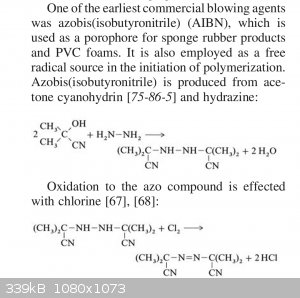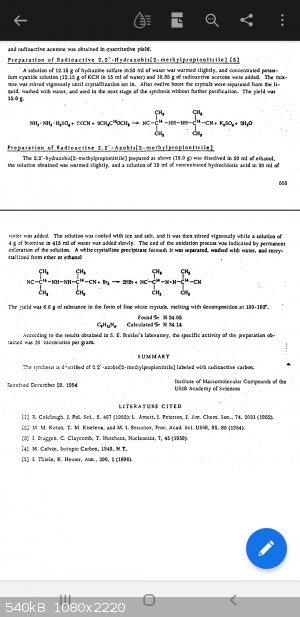Frankenshtein
Harmless

Posts: 25
Registered: 20-11-2018
Location: ahead
Member Is Offline
Mood: oligomerized
|
|
Azobisisobutyronitrile (AIBN) Synthesis Options
This compound requires hydrazine and acetone cyanohydrin, followed by Chlorine oxidization.
The beginner question is, can I use hydrazine sulfate? Hydrazine hydrate? Anything but free base hydrazine? I ask for the obvious reason of safety.
I know the water in the hydrate is a polar protic solvent and I assume it would have to be removed by heating or a nearby drying agent before
attempting the chlorine oxidization.
I am only interested in <1 gram amounts.

|
|
|
Frankenshtein
Harmless

Posts: 25
Registered: 20-11-2018
Location: ahead
Member Is Offline
Mood: oligomerized
|
|
On hydrazine hydrate:
From wikipedia: "The principal hazards of acetone cyanohydrin arise from its ready decomposition on contact with water, which releases highly toxic
hydrogen cyanide."
https://patents.google.com/patent/JP5852183B2/en
Acetone cyanohydrin and hydrazine hydrate would form hydrazobisisobutyronitrile, a different compound.
_______________________________________________________________
So the hydrate is not an option, but hydrazine sulfate?
On hydrazine sulfate:
Some luck was found but with a deuterated form that confuses me:
https://pubs.acs.org/doi/pdf/10.1021/ja00779a036
"AIBN-d, was prepared by the same method using acetone-d6 (99.6 atom Z, Stohler), hydrazine sulfate which had been ex- changed three times with D20 in
a Soxhlet extractor, sodium cyanide dried over P2O5 under vacuum, and D20 solvent."
I found enough information, I believe. The similarities and likely irrelevant things like different names, radiation, or deuteration, between these
three papers has me thinking they are good matching sources for the synthesis.
https://pubs.acs.org/doi/pdf/10.1021/ja01682a040
Picture from this source:
https://link.springer.com/article/10.1007/BF01167334
So potassium cyanide or sodium cyanide, with acetone or methyl ethyl ketone, and hydrazine sulfate. Oxidation could be done by chlorine or bromine.
Not impossible for the amateur.
Sodium with potassium ferrocyanide -> purest NaCN

[Edited on 19-9-2020 by Frankenshtein]
|
|
|
njl
National Hazard
   
Posts: 609
Registered: 26-11-2019
Location: under the sycamore tree
Member Is Offline
Mood: ambivalent
|
|
IDK if you're still planning on doing this but the cyanohydrin is far more dangerous than freebase hydrazine.
|
|
|